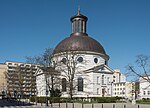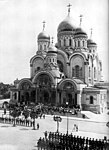Society for the Encouragement of Fine Arts in Warsaw

The Society for the Encouragement of Fine Arts in Warsaw (Towarzystwo Zachęty Sztuk Pięknych w Warszawie) was an independent arts organization founded in Warsaw, then Kingdom of Poland, in 1860. Its main goal was to support and popularize Polish art through active acquisitions, providing help for young artists through scholarships, as well as publishing and organizing exhibitions and art competitions, among other activities. The society remained active until the Nazi invasion of Poland in 1939 and was officially shut down in 1942. The former building of the Society for the Encouragement of Fine Arts in Małachowski Square in Warsaw currently houses the Zacheta National Gallery of Art, a major Central and Eastern European museum dedicated to modern and contemporary art.
Excerpt from the Wikipedia article Society for the Encouragement of Fine Arts in Warsaw (License: CC BY-SA 3.0, Authors, Images).Society for the Encouragement of Fine Arts in Warsaw
Plac Stanisława Małachowskiego, Warsaw Śródmieście
Geographical coordinates (GPS) Address Phone number Website Nearby Places Show on map
Geographical coordinates (GPS)
| Latitude | Longitude |
|---|---|
| N 52.239 ° | E 21.011 ° |
Address
XI Liceum Ogólnokształcące im. Mikołaja Reja
Plac Stanisława Małachowskiego
00-056 Warsaw, Śródmieście
Masovian Voivodeship, Poland
Open on Google Maps











